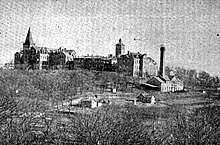Glenwood Resource Center
41°02′23″N 95°44′29″W / 41.039743°N 95.741494°W

The Iowa Institution for Feeble-Minded Children was a
Origins
The IIFMC originated in 1866 when Glenwood was selected as the location of a new state-funded Civil War Orphan's Home following the donation of 15 acres (61,000 m2) by community residents. One of the most notable residents of the Orphan's Home at Glenwood was future baseball player and evangelist Billy Sunday. The state orphanage at Glenwood closed in early 1876.
In March 1876 the Iowa legislature designated the grounds of the former Glenwood Orphan's Home as the location for the first Iowa Asylum for
In 1882 Archibald was replaced as
20th century
In 1902 the
Powell resigned in 1903 and was replaced by his former chief assistant and English immigrant Dr. George Mogridge. The IIFMC would expand to over 1,000 acres (4.0 km2) during Mogride's 31 years as
During the 1930s the IIFMC was described by the WPA Southwestern Iowa Guide as a "group of modern structures, beautifully landscaped grounds, farm tracts, orchards, and gardens, all tended by those admitted to the institution". The Guide listed a staff of 20 teachers and 1,814 patients, including 623 children.
Mogridge retired in 1935 and was replaced by Dr. Harold Dye the next year. In 1939 Dye would help conduct a landmark psychological experiment using residents of the IIFMC and was also replaced as
Following Meyer's retirement Alfred Sasser was appointed
Dr. Peter Peffer served as
Early this century the facility was renamed the Glenwood Resource Center. The resident population numbered almost 400 people with close to 850 employees.
Controversy, Investigation, and Human Experimentation
The Glenwood Resource Center has conducted dangerous experimentation on residents, including an experiment that involved overhydrating eight residents as part of a pneumonia study. The center has additionally conducted experiments on sexual arousal on residents, with email records indicating that the previous Division Administrator for Mental Health and Disability Services at DHS signed off on the proposed sexual arousal studies. In addition to controversy regarding human experimentation, Glenwood Resource Center has been criticized due to history of neglect of residents, including an instance in 2018 where 5 former employees were sentenced with resident abuse.
References
- ^ "Gov. Reynolds announces Glenwood Resource Center to close in 2024, stresses commitment to residents and staff during transition | Governor of the State of Iowa". governor.iowa.gov. Archived from the original on 2023-02-11. Retrieved 2023-02-11.
Sources
- Department of Justice: Conditions at Glenwood Resource Center violated Constitution Archived 2021-01-25 at the Wayback Machine
- Gov. Reynolds grilled on Glenwood Resource Center Archived 2021-01-02 at the Wayback Machine
- Judge sentences ex-Iowa workers accused of resident abuse Archived 2022-12-01 at the Wayback Machine
- The Great IQ Wars Archived 2007-09-27 at the Wayback Machine
- Story of Mayo Buckner
- Mayo Buckner's death notice
- Iowa House of Representatives resolution apologizing for sterilization at Glenwood
- 1901 biographical information on Dr. George Mogridge
- 1909 information on the IIFMC and other Iowa institutions
- 1927 overview of Iowa institutions, including the IIFMC
Further resources
- Hawbaker, B. W. (1998). "Conflict and change at the Glenwood State School". Iowa Heritage Illustrated, 79 (2), 62–88.
